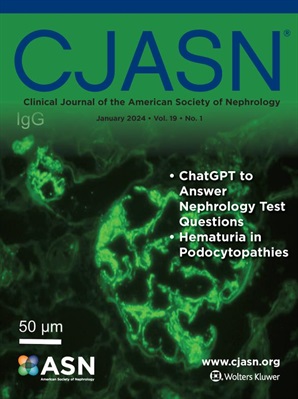Finerenone and Clinical Outcomes in Chronic Kidney Disease and Type 2 Diabetes by Frailty Index: FIDELITY Post Hoc Analysis.
IF 8.5
1区 医学
Q1 UROLOGY & NEPHROLOGY
Clinical Journal of the American Society of Nephrology
Pub Date : 2025-05-02
DOI:10.2215/cjn.0000000700
引用次数: 0
Abstract
INTRODUCTION Frailty is associated with a higher risk of adverse outcomes. It is believed that people with a higher frailty index may be less tolerant to new treatments, often leading to inappropriate prescribing. This post hoc analysis of FIDELITY, a prespecified, pooled analysis of the FIDELIO-DKD and FIGARO-DKD phase 3 clinical trials, investigated the efficacy and safety of finerenone versus placebo according to baseline frailty index. METHODS Between September 2015 and October 2018, 12,990 people with chronic kidney disease (CKD) and type 2 diabetes (T2D) receiving the maximum tolerated dose of a renin-angiotensin system inhibitor were randomized to receive finerenone 10 or 20 mg once daily or placebo. Baseline frailty index was calculated using the Rockwood cumulative deficit approach including 30 clinical characteristics. Primary efficacy outcomes included a kidney (kidney failure, sustained decrease of ≥57% in estimated glomerular filtration rate [eGFR], or kidney-related death) and a cardiovascular (CV) composite outcome (CV death, nonfatal myocardial infarction, nonfatal stroke, or hospitalization for heart failure). Changes in urine albumin-to-creatinine ratio (UACR) and eGFR were measured across the study period. RESULTS Overall, kidney and CV event rates increased with increasing frailty. Finerenone reduced the risk of primary kidney and CV composite outcomes irrespective of baseline frailty (P interaction=0.93 and 0.35, respectively). Compared with placebo, finerenone also demonstrated significant reductions in UACR across all frailty subgroups (P<0.01 for all visits) and significant attenuation of eGFR decline from baseline to month 48 in the three most frail quartiles (>Q1 to ≤Q2, P=0.001; >Q2 to ≤Q3, P<0.001; >Q3, P<0.001, respectively). The incidence of serious adverse events and hyperkalemia increased with increasing frailty in both treatment arms. CONCLUSION Finerenone reduced the risk of CV and kidney events in people with CKD and T2D versus placebo irrespective of baseline frailty status. REGISTRATION FIDELIO-DKD (NCT02540993) and FIGARO-DKD (NCT02545049).菲尼酮与衰弱指数对慢性肾脏疾病和2型糖尿病的临床结局:FIDELITY事后分析
虚弱与不良后果的高风险相关。据信,脆弱指数较高的人可能对新疗法的耐受性较差,往往导致不适当的处方。这项对FIDELIO-DKD和FIGARO-DKD 3期临床试验进行的预先汇总分析,根据基线脆弱指数调查了芬尼酮与安慰剂的疗效和安全性。在2015年9月至2018年10月期间,12990名慢性肾脏疾病(CKD)和2型糖尿病(T2D)患者接受肾素-血管紧张素系统抑制剂的最大耐受剂量,随机分为10或20 mg,每日一次或安慰剂。基线虚弱指数采用Rockwood累积缺陷法计算,包括30个临床特征。主要疗效结局包括肾脏(肾衰竭,肾小球滤过率[eGFR]持续下降≥57%,或肾脏相关死亡)和心血管(CV)复合结局(CV死亡,非致死性心肌梗死,非致死性中风,或因心力衰竭住院)。在整个研究期间测量尿白蛋白与肌酐比值(UACR)和eGFR的变化。结果总体而言,肾脏和CV事件发生率随虚弱程度的增加而增加。芬尼酮降低了原发性肾脏和CV复合结局的风险,与基线虚弱无关(相互作用P分别=0.93和0.35)。与安慰剂相比,芬尼酮还显示所有虚弱亚组的UACR显著降低(PQ1至≤Q2, P=0.001;>Q2至≤Q3, PQ3, P均<0.001)。在两个治疗组中,严重不良事件和高钾血症的发生率随着虚弱程度的增加而增加。结论:与安慰剂相比,芬纳酮降低了CKD和T2D患者CV和肾脏事件的风险,与基线虚弱状态无关。注册号fidelio - dkd (NCT02540993)和FIGARO-DKD (NCT02545049)。
本文章由计算机程序翻译,如有差异,请以英文原文为准。
求助全文
约1分钟内获得全文
求助全文
来源期刊
CiteScore
12.20
自引率
3.10%
发文量
514
审稿时长
3-6 weeks
期刊介绍:
The Clinical Journal of the American Society of Nephrology strives to establish itself as the foremost authority in communicating and influencing advances in clinical nephrology by (1) swiftly and effectively disseminating pivotal developments in clinical and translational research in nephrology, encompassing innovations in research methods and care delivery; (2) providing context for these advances in relation to future research directions and patient care; and (3) becoming a key voice on issues with potential implications for the clinical practice of nephrology, particularly within the United States. Original manuscript topics cover a range of areas, including Acid/Base and Electrolyte Disorders, Acute Kidney Injury and ICU Nephrology, Chronic Kidney Disease, Clinical Nephrology, Cystic Kidney Disease, Diabetes and the Kidney, Genetics, Geriatric and Palliative Nephrology, Glomerular and Tubulointerstitial Diseases, Hypertension, Maintenance Dialysis, Mineral Metabolism, Nephrolithiasis, and Transplantation.

 求助内容:
求助内容: 应助结果提醒方式:
应助结果提醒方式:


